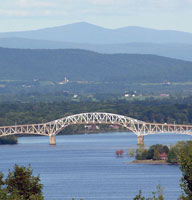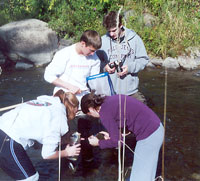Authentic Assessment
"Why do we always say that we can't assess these big important things? We can assess anything. We say we can't because we live in a dysfunctional world that has linked assessment to small, measurable amounts."
Grant Wiggins
Meaningful Work
 Currently, teachers are under enormous pressure to document student achievement. While many students still learn about local matters, teachers often view these experiences as unrelated to the assessment demands placed on them. Field experiences are often seen as an “add-on” or an “extra” and it remains a huge challenge to weave this learning into the every day assessment plans that teachers are required to create.
Currently, teachers are under enormous pressure to document student achievement. While many students still learn about local matters, teachers often view these experiences as unrelated to the assessment demands placed on them. Field experiences are often seen as an “add-on” or an “extra” and it remains a huge challenge to weave this learning into the every day assessment plans that teachers are required to create.
Yet when we isolate the local experiences as “extra” we diminish the huge power of this experiential learning. Teachers who are dedicated to learning outdoors with their students believe it is where the real learning happens. And they discover that there are many ways we can include it as part of a formal assessment plan.
Teachers can use place-based education to build bridges from the world of accountability to the things that matter to us, to our students and to the communities in which we live.
For example, teachers often voice the hope that their students develop a sense of place and responsibility towards one's place. What does this look like for a 10-year-old? A 17-year-old? What do adults do when they are stewards of the land? How can a dialogue about these attributes be part of a learning experience for young people? How can they have rich and authentic experiences of stewardship and be given valuable feedback on how they are doing?

Wendy Scott struggled with these questions when she designed a unit on how people in her community cared for their local environment. Wendy reflects, "It was hard for me to keep a reasonable focus. My essential question "What does it mean to be a steward of the water and land?" COULD cover so many topics and ideas. As I have implemented the unit I have changed some parts but the essence has been the same. The students read stories of stewards—both local and in the rest of the world. They visit places like ECHO and the Mississquoi Wildlife Refuge to learn about stewardship and what it means to the people working in these places. Most importantly, I want them to determine how they themselves can be good stewards of the land and water. It has been fun to see the students get excited about frogs, starfish and whalebones and to meet different people in the community.”
“By linking real tasks with traditional curriculum topics, teachers can approach topics in context, build student understanding, and make connections within and across topics and disciplines.”
(Phillip Moulds, p. 75)
We appreciate Philip Mould’s term, Rich Tasks, when he suggests that the work that students do should be:
- focus on learning a discipline
- connect to a real-world context
- be accessible to all students
Authentic Audience
We also take heed of the words of Steven Levy who encourages us to believe in "The Power of Audience” when he outlines the ways that student work becomes more meaningful when it addresses real needs in the community and is presented to audiences other than the teacher.
Place-based learning invites us to take the work outdoors, into the rivers, along the shores, into the wetlands and engage in problem-solving and creative solutions with community partners.

